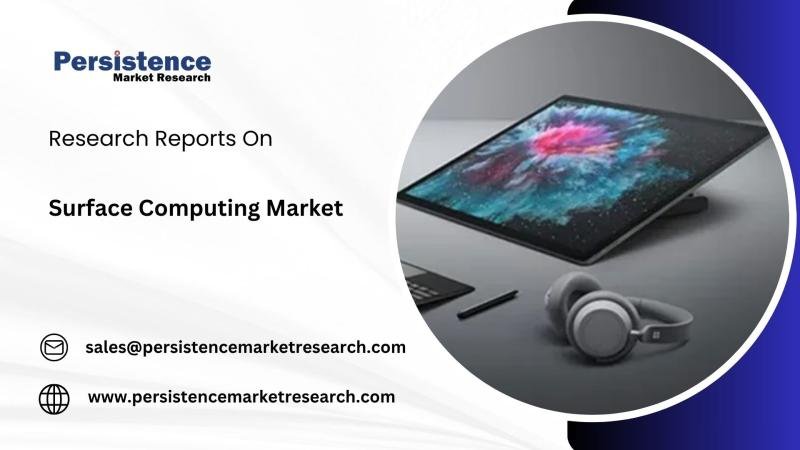The global surface computing market is witnessing a rapid technological transformation, redefining the way humans interact with digital devices. Valued at US$ 47.0 billion in 2023, the market is projected to reach US$ 480.0 billion by 2033, expanding at a remarkable CAGR of 26.2% during the forecast period. This growth is primarily driven by advancements in gesture recognition, touch-sensitive displays, and natural user interfaces that bridge the gap between humans and machines.
North America currently leads the global surface computing landscape, attributed to its strong technology infrastructure, early adoption of digital interfaces, and growing investments in interactive computing across sectors such as retail, hospitality, and healthcare. Meanwhile, the multi-touch display segment remains the largest contributor to market revenue due to its widespread integration in smart devices, collaborative workspaces, and infotainment systems.
Elevate your business strategy with comprehensive market data. Request a sample report now: https://www.persistencemarketresearch.com/samples/33510
Key Highlights from the Report
The surface computing market is projected to grow at a robust CAGR of 26.2% from 2023 to 2033.
Multi-touch technology continues to dominate the market owing to its seamless, intuitive user experience.
North America leads the global market, driven by technological innovation and strong enterprise adoption.
Increasing integration of AI and IoT technologies is enhancing surface computing capabilities.
Growing use cases in retail, automotive, and education sectors are broadening market reach.
Companies are investing in interactive display innovations to create immersive customer engagement experiences.
Market Segmentation
The surface computing market is segmented based on product type, vision systems, touch technology, and end-user industry. Product-wise, interactive tables, walls, and desktops dominate the landscape. Interactive tables are popular in retail and hospitality sectors for enhancing customer interaction, while surface walls are increasingly adopted in corporate and educational environments to facilitate real-time collaboration.
By end-user, the retail sector commands a significant market share as businesses integrate interactive surfaces to personalize customer experiences and streamline operations. The education and healthcare sectors are also witnessing rapid adoption, with surface computing being used for immersive learning, patient monitoring, and collaborative research environments.
Read More: https://www.persistencemarketresearch.com/market-research/surface-computing-market.asp
Regional Insights
North America remains the most prominent market for surface computing, thanks to the presence of major technology giants, strong digital ecosystems, and growing adoption across entertainment, automotive, and enterprise sectors. The U.S. in particular continues to lead with innovations in augmented reality (AR), AI-driven touch systems, and advanced user-interface research.
In contrast, the Asia Pacific region is emerging as a rapidly growing hub for surface computing, driven by the expansion of smart cities, a thriving electronics manufacturing base, and increased investments in digital transformation by countries such as China, Japan, and South Korea. Europe also shows steady growth with demand from automotive design, museums, and public spaces seeking interactive solutions.
Market Drivers
The growing demand for intuitive and immersive user interfaces is the key driver behind the surge in the surface computing market. As businesses and consumers seek more natural ways to interact with technology, the shift from traditional input devices to touch, gesture, and voice-based systems has accelerated. Surface computing delivers precisely that-bridging the gap between physical and digital experiences.
Additionally, the proliferation of smart devices, digital signage, and interactive kiosks across retail, transportation, and education sectors is stimulating demand. Companies are also leveraging surface computing to enhance brand experiences, offering customers an engaging and memorable way to interact with digital content.
Moreover, the integration of artificial intelligence (AI) and Internet of Things (IoT) into surface computing platforms is expanding their functionality. These technologies allow devices to respond intelligently to user interactions, learn behavior patterns, and deliver personalized content, driving enterprise adoption globally.
Market Restraints
Despite its rapid rise, the surface computing market faces several challenges. High manufacturing and implementation costs of touch-sensitive and gesture-recognition hardware remain a major barrier, especially for small and medium enterprises. Advanced surface devices often require complex components, precision engineering, and continuous maintenance, adding to total costs.
Technical limitations also hinder widespread adoption. Multi-user recognition errors, limited gesture accuracy, and latency issues in large-format displays can impact user experience. Additionally, integration with existing IT infrastructure remains a challenge for organizations trying to incorporate surface computing systems at scale.
Privacy and data security concerns further restrain growth, particularly as these systems often rely on sensors and cameras to detect gestures and movements. Without robust cybersecurity measures, the potential for misuse of collected data could slow adoption among privacy-conscious users and industries.
Market Opportunities
The future of surface computing holds vast opportunities across industries. The rise of smart environments, including smart homes, offices, and retail spaces, presents significant growth potential for surface-based interactive systems. These environments rely heavily on seamless, responsive interfaces that connect users to digital ecosystems.
Emerging applications in education and healthcare are also paving the way for innovation. Interactive tables and walls are revolutionizing classroom experiences, while in healthcare, surface computing facilitates real-time data visualization and collaborative diagnostics among medical teams.
Furthermore, the expansion of augmented reality (AR) and virtual reality (VR) technologies offers new dimensions for surface computing integration. As the metaverse evolves, surface devices will likely play a central role in bridging physical and virtual worlds, making the interface more accessible and engaging for end users.
Reasons to Buy the Report
✔ Comprehensive coverage of market dynamics, including growth drivers, restraints, and opportunities.
✔ In-depth analysis of regional trends and competitive landscape for strategic insights.
✔ Detailed segmentation to identify high-growth segments and emerging opportunities.
✔ Access to company profiles and recent developments influencing market expansion.
✔ Forecast data and market projections up to 2033 for informed decision-making.
Do You Have Any Query Or Specific Requirement? Request Customization of Report: https://www.persistencemarketresearch.com/request-customization/33510
Company Insights
Prominent players in the global surface computing market include:
Microsoft Corporation
Apple Inc.
Lenovo Group Ltd.
Dell Technologies Inc.
HP Inc.
Sony Corporation
Samsung Electronics Co., Ltd.
Planar Systems, Inc.
ViewSonic Corporation
TouchMagix Media Pvt. Ltd.
Recent Developments:
In February 2024, Microsoft introduced a new Surface Hub update featuring AI-enhanced collaboration tools and multi-user gesture recognition for enterprise use.
In May 2024, Samsung unveiled its Smart Surface Display Series, designed for retail and hospitality applications, enabling seamless customer interaction and real-time data analytics.
Frequently Asked Questions (FAQs)
How Big is the Surface Computing Market?
Who are the Key Players in the Global Surface Computing Market?
What is the Projected Growth Rate of the Surface Computing Market?
What is the Market Forecast for Surface Computing for 2032?
Which Region is Estimated to Dominate the Surface Computing Industry through the Forecast Period?
Conclusion
The surface computing market represents the next evolutionary leap in human-computer interaction, fostering an era of seamless, intuitive engagement. As the technology matures, it will continue to transform industries-enabling dynamic customer experiences, improving operational efficiency, and reshaping the digital landscape.
With advancements in AI, IoT, and AR driving deeper integration, surface computing is not just a futuristic concept-it’s becoming a critical tool for digital transformation. The next decade promises exponential growth as businesses, educators, and innovators harness this powerful interface to redefine how we connect with technology and the world around us.
Related Reports:
Consent Management Market https://www.persistencemarketresearch.com/market-research/consent-management-market.asp
UV Lamps Market https://www.persistencemarketresearch.com/market-research/uv-lamps-market.asp
Smart Lighting Market https://www.persistencemarketresearch.com/market-research/smart-lighting-market.asp
Contact Us:
Persistence Market Research
Second Floor, 150 Fleet Street,
London, EC4A 2DQ, United Kingdom
USA Phone: +1 646-878-6329
UK Phone: +44 203-837-5656
Email: sales@persistencemarketresearch.com
Web: https://www.persistencemarketresearch.com
About Persistence Market Research:
At Persistence Market Research, we specialize in creating research studies that serve as strategic tools for driving business growth. Established as a proprietary firm in 2012, we have evolved into a registered company in England and Wales in 2023 under the name Persistence Research & Consultancy Services Ltd. With a solid foundation, we have completed over 3600 custom and syndicate market research projects, and delivered more than 2700 projects for other leading market research companies’ clients.
Our approach combines traditional market research methods with modern tools to offer comprehensive research solutions. With a decade of experience, we pride ourselves on deriving actionable insights from data to help businesses stay ahead of the competition. Our client base spans multinational corporations, leading consulting firms, investment funds, and government departments. A significant portion of our sales comes from repeat clients, a testament to the value and trust we’ve built over the years.
This release was published on openPR.


















